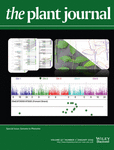Journal list menu
Export Citations
Download PDFs
Issue Information
EDITORIAL
From genome to phenome: genome-wide association studies and other approaches that bridge the genotype to phenotype gap
- Pages: 5-7
- First Published: 12 January 2019
SI GENOME TO PHENOME
Crop genome-wide association study: a harvest of biological relevance
- Pages: 8-18
- First Published: 28 October 2018
This review summarizes the latest advances in generating an overall view of the genetic architecture associated with crop complex traits, and discusses how these updated insights will guide future studies. A multiple-causal-allele hypothesis was formulated to explain the increasingly common artifact/synthetic associations.
Genetic and genomic resources of sorghum to connect genotype with phenotype in contrasting environments
- Pages: 19-39
- First Published: 27 September 2018
Using genetic and genomic resources efficiently and appropriately is critical to advance our understanding of biology and advance crop improvement. We review the myriad genomic resources available and currently in development for the sorghum community.
Evolutionary and ecological functional genomics, from lab to the wild
- Pages: 40-55
- First Published: 16 November 2018
As the drive to understand how organisms adapt in the field has advanced, researchers have explored numerous avenues of investigation. In such, a growing area of research – broadly termed evolutionary and ecological functional genomics (EEFG) – has developed. It has revolutionized how we investigate plant adaptation and evolution. Here we highlight the methods used, salient findings and progress in adopting EEFG-type studies.
Applying the latest advances in genomics and phenomics for trait discovery in polyploid wheat
- Pages: 56-72
- First Published: 08 November 2018
The objective of this review was to discuss how the latest developments in genomics and phenomics can be applied to understand the biology of agronomic traits in polyploid wheat. We describe the new resources and technological developments in the field, and discuss how they can be integrated to improve gene discovery and validation in wheat.
Trait discovery and editing in tomato
- Pages: 73-90
- First Published: 11 November 2018
The pace of trait discovery in tomato has considerably accelerated in recent years thanks to advances in deep sequencing and other ’omics technologies. Here we review the genetic resources and current powerful forward genetic strategies, allowing discovery of QTLs, genes and mutations underlying remarkable traits in tomato. We also show how CRISPR/Cas9 GE now provides unprecedented opportunities for candidate gene validation, creation of new genetic diversity and breeding of improved tomato varieties.
Metabolic GWAS-based dissection of genetic bases underlying the diversity of plant metabolism
- Pages: 91-100
- First Published: 19 September 2018
In this review, we highlight some recent progress in the dissection of metabolic diversity, with an emphasis on metabolic genome-wide association study (mGWAS) and mGWAS-based multi-dimensional analysis.
Multi-omics data-driven investigations of metabolic diversity of plant triterpenoids
- Pages: 101-111
- First Published: 19 October 2018
This paper describes current plant metabolic studies driven by implementation of multi-omics data and the key biosynthetic procedures that lead to the great diversity of plant triterpenoids.
Converging phenomics and genomics to study natural variation in plant photosynthetic efficiency
- Pages: 112-133
- First Published: 12 December 2018
The fields of genomics and phenomics in plant science have gone through a major revolution that has led to the technological and methodological maturation of both fields of study in the past decade. Expansion of high-throughput phenotyping technology will soon allow the scaling up of forward genetics approaches in order to adequately study the genetic architecture of traits that may accelerate the much needed improvement of photosynthesis in crop plants.
Cell wall traits that influence plant development, immunity, and bioconversion
- Pages: 134-147
- First Published: 13 December 2018
The importance of cell wall pectin in influencing plant growth and developmental processes, defenses against microbes and saccharification efficiency of plant biomass is thoroughly discussed in this review. Sensing the cell wall is crucial in many developmental and immunity responses and may occur through the perception of released damage-associated molecular patterns (DAMPs) from pectin and other cell wall components.
Salt stress under the scalpel – dissecting the genetics of salt tolerance
- Pages: 148-163
- First Published: 12 December 2018
The improvement of salt tolerance in crops is imperative for addressing yield penalties in saline soils and enabling the use of brackish water for irrigation. Major advances in high-throughput phenotyping, data analysis, sequencing technologies and statistical genetics are empowering investigations into the mechanisms and genetics of salt tolerance, drawing upon an ever-expanding suite of genetic resources. Bridging the genotype–phenotype gap to gain insights into the mechanisms of salt tolerance in plants is becoming practical.
Genome-wide association studies on the phyllosphere microbiome: Embracing complexity in host–microbe interactions
- Pages: 164-181
- First Published: 22 November 2018
Genome-wide association studies can identify the plant genetic variation associated with phyllosphere microbiomes in nature, and thus provide insight on how host plants might influence the microbiota. Detection of these associations with GWAS depends on how host plants are sampled and genotyped, how complex microbial communities are reduced to phenotypes, and how the effects of environment on plant–microbe interactions are exposed by study design.
Computational aspects underlying genome to phenome analysis in plants
- Pages: 182-198
- First Published: 30 November 2018
This review addresses the state of the art on plant genome sequencing, phenotyping and how to bridge these. Genome sequencing sees a new revolution and phenotyping is becoming extremely important.
Diverse paths to hybrid incompatibility in Arabidopsis
- Pages: 199-213
- First Published: 11 August 2018
The advances of high-throughput technologies have allowed the use of Arabidopsis hybrids not only to investigate the genetic mechanisms but also to obtain evolutionary insights on the maintenance of incompatibility alleles in nature. In this review we highlight the current knowledge of the diversity of genetic and evolutionary mechanisms known to contribute to hybrid incompatibility in Arabidopsis genus.




